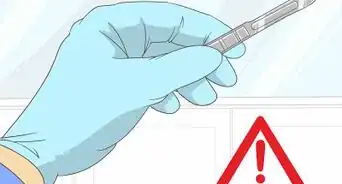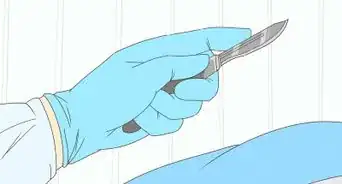This article was medically reviewed by Shari Forschen, NP, MA. Shari Forschen is a Registered Nurse at Sanford Health in North Dakota. Shari has worked in healthcare since 1996 and her expertise lies in acute care bedside nursing on a medical oncology floor. She received her degree from Medcenter one College of Nursing in 2003 and her Family Nurse Practitioner Masters from the University of North Dakota in 2014. Shari is a member of the American Nurses Association.
There are 9 references cited in this article, which can be found at the bottom of the page.
This article has been viewed 53,454 times.
Circumcising your son is a big decision. You should do some research on the issue and weigh all the possible risks and benefits — before your child is born, if possible, so that it can be included in your birth plan. In the United States, circumcision is often performed prior to leaving the hospital after the baby is born. Certain religious customs may require the circumcision to be done in the days following the baby's birth. Take steps to ensure your son's circumcision is safe by planning carefully and making sure he is healthy before the procedure. You may also consider leaving the decision to your son for him to make as an adult.
Steps
Planning the Circumcision
-
1Consider allowing your son to make the decision for himself when he becomes an adult. Circumcision is a major medical procedure on a very intimate/private part of the body, and not all men who are circumcised are happy with the result and decision made for them. Many wish they had a choice instead of their parents making the choice for them, so consider allowing your son bodily autonomy. If your son wishes to be circumcised when he becomes an adult, he can be aware of the pros and cons and make an informed choice to consent to the procedure and still have it done. Conversely, if your son is circumcised but grows up and wishes he was not, his options are limited.
- Even so-called "foreskin restoration" does not restore all the structures removed during circumcision, since circumcision often removes (to varying degrees) other structures of the penis like the frenulum and ridged band that cannot be regrown.[1]
-
2Speak to your physician about performing the circumcision. Having a qualified medical professional that you are comfortable with is one of the most important aspects of planning for a circumcision. Select one who is experienced, medically licensed, and certified to perform circumcisions.
- Most pediatricians do provide this service prior to baby being discharged from the hospital.
Advertisement -
3Discuss the need for adequate pain relief. Talk to your doctor about what she recommends for pain relief for your son during and after the circumcision. Local anesthesia is usually all that is considered necessary — general anesthesia should not be used on infants.[2]
- There is debate as to pain relief options when performing a circumcision. Injectable anesthesia is most often used for circumcision — the dorsal penile nerve block, which is delivered via two injections, is used in 85% of cases in the US. Another injectable option, known as ring block, has also proven to be extremely effective.[3] Topical creams, such as EMLA cream, may also be an option. Ensure that you are comfortable with what is recommended and if not, you can obtain a second opinion.
- Newborns do experience pain, and research has proven that local anesthesia is safe and effective, so make sure your doctor is using adequate pain relief measures during the procedure.
- This may be another reason to forego circumcision and allow your son to make the choice when he becomes an adult.
-
4Go over safety precautions. Safety measures must be in place to ensure a safe and efficient circumcision for your son. Ask your doctor what kinds of safety precautions he will implement during the procedure. This includes the use of a shield to protect the glans (acorn-shaped end of the penis) from being accidentally cut during circumcision.
- The most popular shield is the Gomco shield, though many others are available.
-
5Familiarize yourself with the process. The physician should talk you through the procedure and techniques, as well as the sanitary precautions taken. You should feel comfortable with every step of the procedure and confident that you fully understand the entire process. Make sure this is part of the birth plan and education prior to delivering and that you do plenty of research beforehand so you are prepared. Discuss these details with your doctor so you can be aware of what to expect, both for yourself and for your son.[4] There are three different methods typically used for circumcision:
- The Gomco Clamp – With this method, the doctor uses a probe to separate the foreskin from the head of the penis. After that, a bell-shaped device is fitted over the head of the penis and under the foreskin, which may require an incision in the foreskin. The foreskin is pulled up over the bell and a clamp is tightened around it to reduce blood flow to the area. Finally, a scalpel is used to cut and remove the foreskin.
- The Mogen Clamp – With this method, the doctor also uses a probe to separate the foreskin from the head of the penis. Then the foreskin is pulled out away from the head and inserted into a metal clamp. The doctor will hold the clamp in place while the foreskin is cut with a scalpel. The clamp will remain in place for a few minutes to ensure all of the bleeding has stopped.
- The Plastibell Technique – With this method (similarly to the Gomco Clamp method), the doctor uses a probe to separate the foreskin from the head of the penis. Then the bell-shaped device is fitted over the head of the penis and under the foreskin. Next, a piece of suture is tied around the foreskin to cut off the blood circulation to the foreskin. The doctor will then use a scalpel to cut off the extra foreskin, but the suture is left on. It will fall off on its own approximately three to seven days later.
Deciding if He's Ready for Circumcision
-
1Make sure he's generally healthy. Ensure the infant has been thoroughly examined by a physician or nurse practitioner and has no physical problems. Before you move forward with the circumcision, you should make sure there are no physical warning signs or abnormalities, especially to his penis.[5]
- Sometimes it is necessary to wait until your child is older to perform a circumcision. For example, if your child has a condition called phimosis in which the foreskin is too tight to be pulled back over the head of the penis.[6]
- In these cases, circumcision will be postponed until the child is two years old (or even until puberty, if the parents so choose); however, there can be more complications, more pain and associated trauma, and a longer healing time for an older child, so you must take the proper precautions and consider your choice carefully since circumcision is essentially an elective surgery.
- Newborns typically recover from the surgery within 24 hours. Older children and adults can take three to four days for recovery.[7]
- For older children or adults, you might consider general anesthesia. This poses certain risks, but can reduce possible trauma related to undergoing the surgery while awake.[8] [9]
-
2Check for healthy weight. This is always taken into factor by the physician performing the circumcision. She will verify that the infant was born at full term, or nearly so, and weighs five pounds or more. If your son was premature at birth or weighed less than five pounds, you should consider waiting until he has reached this weight requirement before doing the circumcision.
-
3Ensure there are no family-related risks. Make sure that his family history has been investigated and there are no bleeding disorders. An issue like this could make a circumcision more risky. Be sure to discuss these issues with your doctor well in advance.[10]
- During the pregnancy, health problems of both father and mother should be discussed to assess risks and benefits of the circumcision and other procedures. This assessment can help avoid any unforeseen problems; however, even with the best assessments, life can offer surprises that are unforeseen.
-
4Check that he is stable. This means that your son should be eating well and gaining, not losing weight. Consider postponing the circumcision for at least seven or eight days if these conditions are not met.
-
5Be aware of how birth conditions can affect circumcision. Check that he has recovered from jaundice or from the birth trauma, if the birth was traumatic. It is important that your son be as healthy and stable as possible before moving forward with the circumcision.
Caring for Your Son After the Circumcision
-
1Find out about common post-procedure care issues. Ask your doctor about what you should expect after the procedure and what you will need to do to care for your son after his circumcision. Get details on how to care for any post-circumcision issues from the physician, including:
- Instructions for aftercare
- Pain relief
- Special diaper changing instructions
-
2Watch for problems during healing. For about a week after the surgery, you will need to be extra diligent in caring for your son while he heals from the circumcision. Understand what symptoms might require medical intervention and know what to look for during healing.[11]
- Some problems to watch for include oozing from the surgical site, continued bleeding around the circumcised area, abnormal urination patterns (or no urination), or other signs of infection as a result of the surgery.
-
3Set a follow-up appointment. You will need to have the circumcision checked to assess the healing process and see if there's any need for additional surgery. Typically, your doctor will schedule the follow-up appointment for one to two weeks after the procedure.[12]
-
4Be prepared for the care required during post-surgery healing. This is a crucial time for your son in which he’ll need extra care to ensure his circumcision heals properly. This is a major issue that will affect him for the rest of his life so you’ll need to be diligent in your care after the procedure to reduce the risk of scarring or other damage that could affect him into adulthood.[13]
- Keep the penis clean.
- Keep the area covered with a healing lotion, such as petroleum jelly, perhaps on a gauze wrapped (but never taped) around his circumcised penis.
- Know how to stem minor bleeding, specifically using sterile contact methods. Add a little pressure to the area that is bleeding.
Expert Q&A
-
QuestionHow is a circumcision performed?
 Shari Forschen, NP, MAShari Forschen is a Registered Nurse at Sanford Health in North Dakota. Shari has worked in healthcare since 1996 and her expertise lies in acute care bedside nursing on a medical oncology floor. She received her degree from Medcenter one College of Nursing in 2003 and her Family Nurse Practitioner Masters from the University of North Dakota in 2014. Shari is a member of the American Nurses Association.
Shari Forschen, NP, MAShari Forschen is a Registered Nurse at Sanford Health in North Dakota. Shari has worked in healthcare since 1996 and her expertise lies in acute care bedside nursing on a medical oncology floor. She received her degree from Medcenter one College of Nursing in 2003 and her Family Nurse Practitioner Masters from the University of North Dakota in 2014. Shari is a member of the American Nurses Association.
Master's Degree, Nursing, University of North Dakota Medical professionals do this procedure and it should not be performed outside of this setting as is a surgical procedure and needs proper follow up to prevent infection and management of any complications. This wikiHow article gives information about how they are performed and information so you can decide if it's the right choice for your son.
Medical professionals do this procedure and it should not be performed outside of this setting as is a surgical procedure and needs proper follow up to prevent infection and management of any complications. This wikiHow article gives information about how they are performed and information so you can decide if it's the right choice for your son.
Warnings
- There are risks to circumcision, usually minor, which include bleeding, infection, and swelling. Sometimes, too little or too much foreskin is removed and more surgery may be needed. Risk of accidentally cutting off part of the glans, however, can be eliminated with the use of an adequate protective shield, such as the Gomco shield. Risk of death is exceedingly rare; less than 1 in 500,000 to 18 million.⧼thumbs_response⧽
- Consider your son's future feelings.⧼thumbs_response⧽
References
- ↑ http://www.cirp.org/library/anatomy/taylor/
- ↑ http://www.circinfo.net/anesthesia.html
- ↑ http://www.circinfo.net/anesthesia.html
- ↑ http://www.mayoclinic.org/tests-procedures/circumcision/basics/what-you-can-expect/prc-20013585
- ↑ http://patient.info/doctor/circumcision-pro
- ↑ http://www.cedars-sinai.edu/Patients/Programs-and-Services/Pediatrics/Treatment/Pediatric-Urology/Circumcision.aspx
- ↑ http://www.childrenshospital.org/conditions-and-treatments/treatments/circumcision
- ↑ http://www.chp.edu/our-services/urology/patient-procedures/circumcision
- ↑ http://www.childrenshospital.org/conditions-and-treatments/treatments/circumcision
- ↑ https://medicine.yale.edu/surgery/pediatric/care/information/outpatient/circumcision.aspx
- ↑ http://www.webmd.com/parenting/baby/tc/circumcision-risks
- ↑ https://medicine.yale.edu/surgery/pediatric/care/information/outpatient/circumcision.aspx
- ↑ https://medicine.yale.edu/surgery/pediatric/care/information/outpatient/circumcision.aspx











































































Medical Disclaimer
The content of this article is not intended to be a substitute for professional medical advice, examination, diagnosis, or treatment. You should always contact your doctor or other qualified healthcare professional before starting, changing, or stopping any kind of health treatment.
Read More...